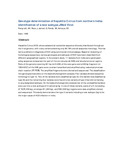| dc.contributor.author | Panigrahi, AK | |
| dc.contributor.author | Roca, J | |
| dc.contributor.author | Jameel, S | |
| dc.contributor.author | Panda, SK | |
| dc.contributor.author | Acharya, KS | |
| dc.date.accessioned | 2013-07-04T12:06:22Z | |
| dc.date.available | 2013-07-04T12:06:22Z | |
| dc.date.issued | 1996 | |
| dc.identifier.citation | KIRTDA, DRACHARYAS. 1996. Panigrahi AK, Roca J, Acharya SK, Jameel S, Panda SK.Genotype determination of hepatitis C virus from northern India: identification of a new subtype.J Med Virol. 1996 Feb;48(2):191-8 | en |
| dc.identifier.uri | http://profiles.uonbi.ac.ke/sacharya/publications/panigrahi-ak-roca-j-acharya-sk-jameel-s-panda-skgenotype-determination-hepatit | |
| dc.identifier.uri | http://erepository.uonbi.ac.ke:8080/xmlui/handle/123456789/45277 | |
| dc.description.abstract | Hepatitis C virus (HCV) shows substantial nucleotide sequence diversity distributed throughout the viral genome, with many variants showing only 68-79% overall sequence homology. This has led to problems in diagnosis of HCV using commercial immunoassays. Based on clustering of homologous sequences, various genotypes and subtypes of HCV have been described from different geographical regions. In the present study, 11 isolates from India were genotyped using sequence comparison for part of the non-structural (NS5) and structural (core) regions. Parts of the genome covering 451 bp (nt 9-459) of the core gene and a 249 bp fragment (nt 7959-8207) of the NS5 gene were reverse transcribed and amplified using nested polymerase chain reaction (RT-PCR). The amplified fragments were cloned and sequenced. The classification into genotypes was done on the basis of phylogenetic analysis. Four isolates showed sequence homology to type 1b. Two of the isolates were classified as type 3a. One isolate was classified as type 3b and the remaining four isolates were found to be variants of type 3 but did not belong to any designated subtype. On the basis of phylogenetic analysis two of the unclassified isolates were put into a new subtype of 3 named as 3g. In one of these variants, parts of a 5'-noncoding (5' NCR; 204 bp), envelope-E1 (435 bp), and NS3 (502 bp) regions were also amplified, cloned, and sequenced. This study demonstrates the type 3 variants including a new subtype (3g) to be the major cause of HCV infection in India. | en |
| dc.language.iso | en | en |
| dc.title | Genotype determination of hepatitis C virus from northern India: identification of a new subtype.J Med Virol. | en |
| dc.type | Article | en |
| local.publisher | Department of Medicine, College of Health Sciences, University of Nairobi | en |

